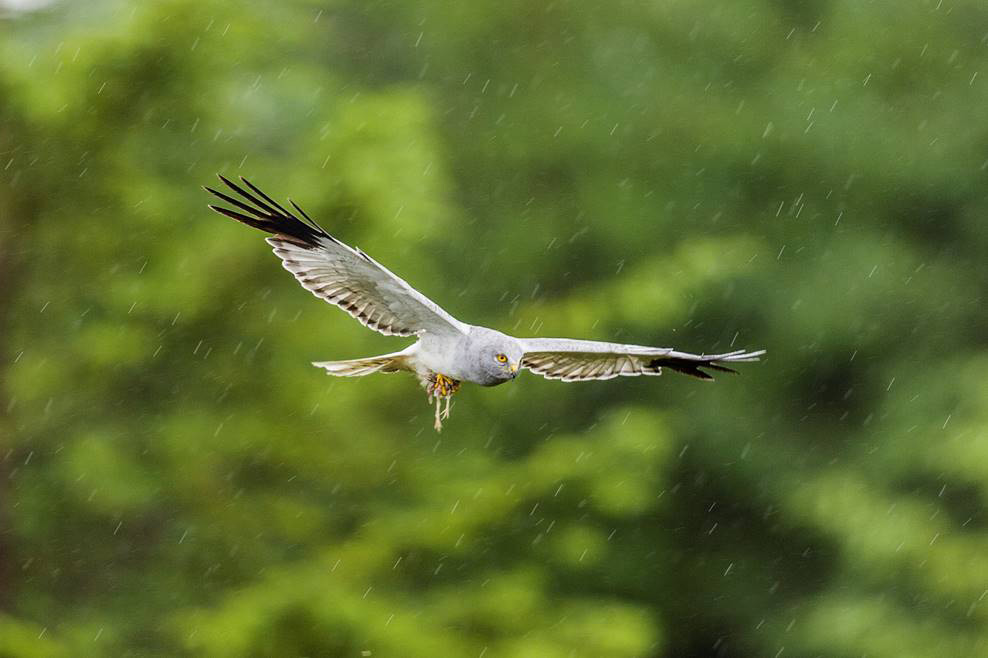A new study led by University College Cork taps into expert knowledge from across Europe to identify the threats and the most effective conservation strategies for two emblematic birds of prey: hen harriers and short-eared owls.
The research, published this week in the journal Bird Conservation International, highlights worrying declines in both species’ numbers in the face of similar threats, and stresses that designation of protected areas is not sufficient in reversing the declines and this needs to be combined with proactive habitat and species management to be effective.
Led by Dr Darío Fernández-Bellon of University College Cork (UCC) and MKO Research, the researchers collected information from experts on the threats facing hen harriers and short eared owls, as well as conservation strategies for each species.
Dr Fernández-Bellon notes, “A lot of effort goes into studying and monitoring these iconic birds throughout Europe, but unfortunately, this work is hard to access and often has little impact outside the areas where the studies are carried out.
“We contacted experts across Europe to bring together their findings. European hen harrier and short-eared owl populations are highly connected, so we need to share information internationally when it comes to their conservation.”
HABITAT LOSS
Experts were asked to rate the importance of different threats to hen harriers and short-eared owls in their areas.
“Most populations of both species are affected by ecological factors (such as predation or extreme weather), changes in land use (like habitat loss or agricultural intensification) and accidental nest destruction by humans.
“Despite broad similarities, some threats are more specific to some areas; for example, habitat loss due to commercial forest plantation is perceived as a major threat to hen harriers in Ireland, while in the UK these same birds are most threatened by shooting and poisoning,” said Dr Fernández-Bellon.
COMBINATION OF ACTIONS NEEDED
When rating the effectiveness of different strategies to protect these birds, experts indicated that protected areas such as national parks, nature reserves and SPA’s (special protection areas designated for these species) were the most common conservation strategy.
However, results suggest that protected areas on their own are not enough to save these birds.
“These areas are often protected on paper, but not in practice,” said Prof John O’Halloran of UCC and co-author of the study. “Our work suggests that they need to be combined with proactive conservation actions, like restoring and enhancing habitats and protecting nests from predators and from illegal hunting and poisoning”.
When asked what lies ahead for these two species, Dr Fernández-Bellon concluded “We still have a lot to learn about short-eared owls.
“They are a species that is hard to monitor, and international studies to understand their movements across Europe are a key first step.
“For hen harriers, it is time to develop a Europe-wide action plan to protect this charismatic species. In light of their widespread decline, increasing their protection status may also be necessary.”
URGENT ACTION NECESSARY
The shortcomings of protected areas for these species are evident in Ireland where, hen harrier populations within the Special Protection Areas designated for their conservation, continue to decline.
BirdWatch Ireland Raptor Conservation Officer and coauthor of the study, John Lusby, said: “We must be proactive to save these birds from extinction. Once conservation measures are in place, we should not think the problem is solved, it is also necessary to evaluate whether these measures are working, and to improve them when required.
“The Hen Harrier Program, an agri-environmental scheme in the SPA network that rewards farming practices that benefit hen harriers and biodiversity, is a step in the right direction. However, as our study shows, designating protected areas is not sufficient, and there is an urgent need for developing long-term management plans for the SPA’s with clear conservation objectives.
“Otherwise we will continue to see declines in hen harrier populations. The Irish government is due to publish a Hen Harrier Threat Response Plan and we hope that the recommendations and lessons from this study are taken on board.”








